A Field Survey on Indoor Climate in Land Transport Cabins of Buses and Trains
Abstract
1. Introduction
2. Materials and Methods
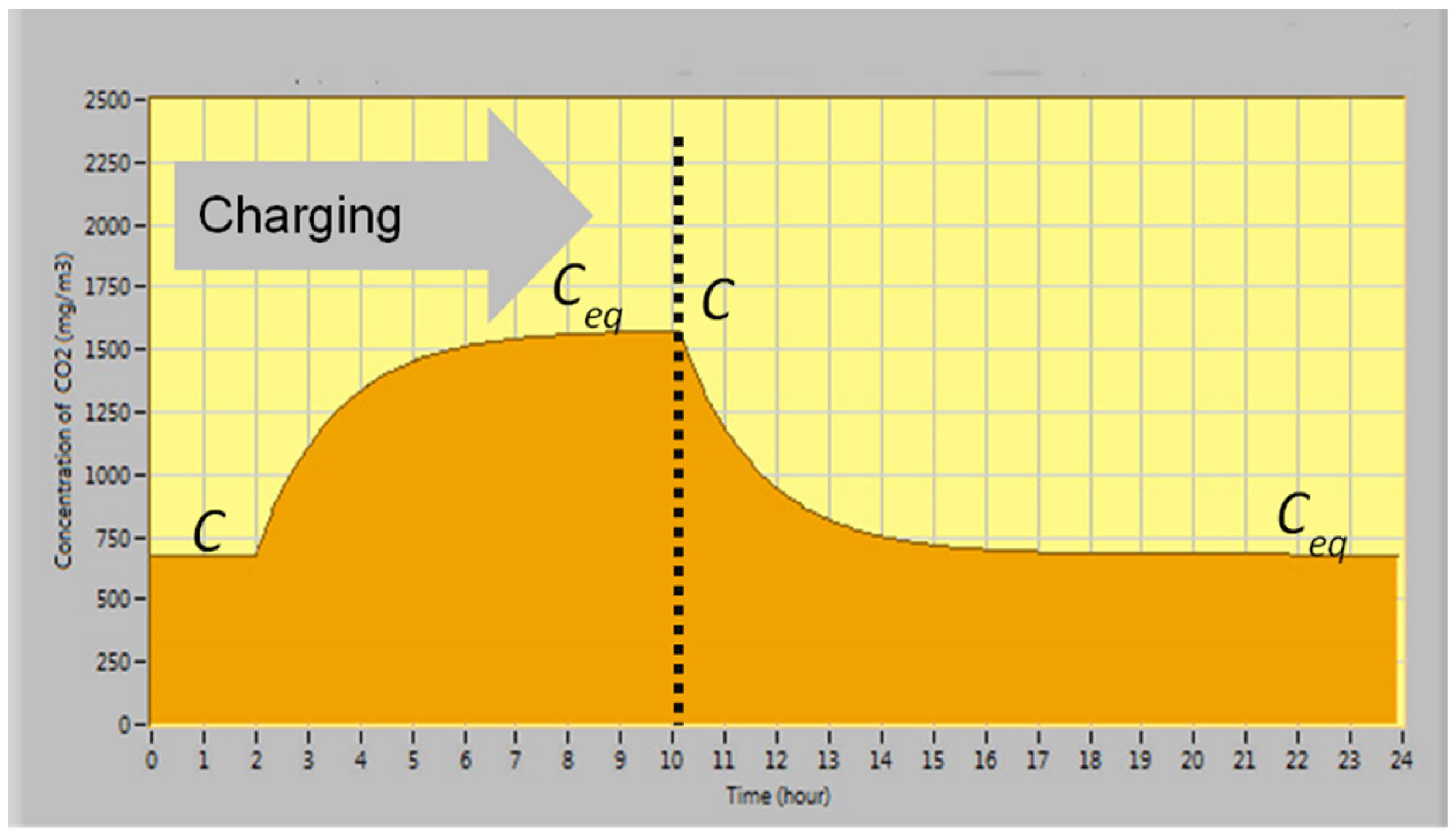
3. Results and Discussion
4. Conclusions
Supplementary Materials
Author Contributions
Funding
Institutional Review Board Statement
Informed Consent Statement
Data Availability Statement
Acknowledgments
Conflicts of Interest
References
- Al Horr, Y.; Arif, M.; Katafygiotou, M.; Mazroei, A.; Kaushik, A.; Elsarrag, E. Impact of indoor environmental quality on occupant well-being and comfort: A review of the literature. Int. J. Sustain. Built Environ. 2016, 5, 1–11. [Google Scholar] [CrossRef]
- EN 16798-1:2019; Energy Performance of Buildings—Part 1: Indoor Environmental Input Parameters for Design and Assessment of Energy Performance of Buildings Addressing Indoor Air Quality, Thermal Environment, Lighting, and Acoustics—Module M1-6. British Standards Institution: London, UK, 2019. Available online: https://www.en-standard.eu/bs-en-16798-1-2019-energy-performance-of-buildings-ventilation-for-buildings-indoor-environmental-input-parameters-for-design-and-assessment-of-energy-performance-of-buildings-addressing-indoor-air-quality-thermal-environment-l (accessed on 20 October 2022).
- Steer, D.G. Comprehensive Study on Passenger Transport by Coach in Europe DG MOVE, European Commission Final Report; London, UK. 2016; Available online: https://transport.ec.europa.eu/document/download/d2c3465b-ba10-4edd-8d8d-fc4b2bc185fa_en?filename=2016-04-passenger-transport-by-coach-in-europe.pdf (accessed on 4 May 2022).
- ACEA. Fact Sheet-Buses. Available online: https://www.acea.auto/files/buses_fact_sheet_ACEA.pdf (accessed on 4 May 2023).
- [Dataset] Eurostat. Railway Passenger Transport Statistics-Quarterly and Annual Data. 2019. Available online: https://ec.europa.eu/eurostat/statisticsexplained/ (accessed on 4 May 2022).
- Pimenta, A.M.; Assunção, A. Thermal discomfort and hypertension in bus drivers and chargers in the metropolitan region of Belo Horizonte, Brazil. Appl. Ergon. 2015, 47, 236–241. [Google Scholar] [CrossRef] [PubMed]
- Velt, K.; Daanen, H. Optimal bus temperature for thermal comfort during a cool day. Appl. Ergon. 2017, 62, 72–76. [Google Scholar] [CrossRef] [PubMed]
- Zhang, B.; Xue, T.; Hu, N. Analysis and improvement of the comfort performance of a car’s indoor environment based on the predicted mean vote–predicted percentage of dissatisfied and air age. Adv. Mech. Eng. 2017, 9, 1687814017695693. [Google Scholar] [CrossRef]
- Hodder, S.G.; Parsons, K. The effects of solar radiation on thermal comfort. Int. J. Biometeorol. 2006, 51, 233–250. [Google Scholar] [CrossRef] [PubMed]
- Yang, L.; Li, X.; Tu, J. Thermal comfort analysis of a high-speed train cabin considering the solar radiation effects. Indoor Built Environ. 2019, 29, 1101–1117. [Google Scholar] [CrossRef]
- Maier, J.; Zierke, O.; Hoermann, H.-J.; Goerke, P. Effects of personal control for thermal comfort in long-distance trains. Energy Build. 2021, 247, 111125. [Google Scholar] [CrossRef]
- Su, C.-Q.; Liang, X.-X.; Wang, Y.-P.; Yang, Y.-F.; Su, J.-J.; Liu, X. Analysis of Human Thermal Comfort in Bus Based on Thermoelectric Cooling Climate-Controlled Seats. Int. J. Energy Res. 2023, 2023, 6918866. [Google Scholar] [CrossRef]
- Skorge, T.D.; Eagan, T.M.L.; E Eide, G.; Gulsvik, A.; Bakke, P.S. Indoor exposures and respiratory symptoms in a Norwegian community sample. Thorax 2005, 60, 937–942. [Google Scholar] [CrossRef]
- You, B.; Zhou, W.; Li, J.; Li, Z.; Sun, Y. A review of indoor Gaseous organic compounds and human chemical Exposure: Insights from Real-time measurements. Environ. Int. 2022, 170, 107611. [Google Scholar] [CrossRef]
- Mei, S.; Chen, B.; Zhu, Y.; Lees, M.; Boukhanovsky, A.; Sloot, P. Simulating city-level airborne infectious diseases. Comput. Environ. Urban Syst. 2015, 51, 97–105. [Google Scholar] [CrossRef]
- Nasir, Z.A.; Campos, L.C.; Christie, N.; Colbeck, I. Airborne biological hazards and urban transport infrastructure: Current challenges and future directions. Environ. Sci. Pollut. Res. 2016, 23, 15757–15766. [Google Scholar] [CrossRef] [PubMed]
- Wei, G.; Yang, X. Effect of temperature on VOC emissions and odor from vehicle carpet. J. Affect. Disord. 2023, 246, 110993. [Google Scholar] [CrossRef]
- Xu, B.; Hao, J. Air quality inside subway metro indoor environment worldwide: A review. Environ. Int. 2017, 107, 33–46. [Google Scholar] [CrossRef] [PubMed]
- Wang, H.; Xiong, J.; Wei, W. Measurement methods and impact factors for the key parameters of VOC/SVOC emissions from materials in indoor and vehicular environments: A review. Environ. Int. 2022, 168, 107451. [Google Scholar] [CrossRef] [PubMed]
- Hossam, M.; Fouad, M.; Abou-Zaid, A. Egypt Numerical Investigation of Airflow Patterns and Thermal Comfort in a Bus Cabin. SAE Int. J. Passeng. Cars Mech. Syst. 2020, 13, 145–156. [Google Scholar] [CrossRef]
- AIsmail, R.; Abdullah, S.N.A.; Abdullah, A.A.; Hamid, M.R.A.; Deros, B.M. Relationship between thermal comfort and driving performance among Malaysian bus driver. ARPN J. Eng. Appl. Sci. 2015, 10, 7406–7411. [Google Scholar]
- Makowiec-Dąbrowska, T.; Gadzicka, E.; Siedlecka, J.; Szyjkowska, A.; Viebig, P.; Kozak, P.; Bortkiewicz, A. Climate conditions and work-related fatigue among professional drivers. Int. J. Biometeorol. 2018, 63, 121–128. [Google Scholar] [CrossRef]
- Shek, K.W.; Chan, W.T. Combined comfort model of thermal comfort and air quality on buses in Hong Kong. Sci. Total Environ. 2008, 389, 277–282. [Google Scholar] [CrossRef]
- Almeida, M.d.N.; Xavier, A.A.d.P.; Michaloski, A.O. A Review of Thermal Comfort Applied in Bus Cabin Environments. Appl. Sci. 2020, 10, 8648. [Google Scholar] [CrossRef]
- Lin, T.-P.; Hwang, R.-L.; Huang, K.-T.; Sun, C.-Y.; Huang, Y.-C. Passenger thermal perceptions, thermal comfort requirements, and adaptations in short- and long-haul vehicles. Int. J. Biometeorol. 2009, 54, 221–230. [Google Scholar] [CrossRef] [PubMed]
- Almeida, M.D.N.; de Paula Xavier, A.A.; Michaloski, A.O.; Soares, A.L. Thermal Comfort in Bus Cabins: A Review of Parameters and Numerical Investigation. In Occupational and Environmental Safety and Health II. Studies in Systems, Decision and Control; Arezes, P.M., Baptista, J.S., Barroso, M.P., Carneiro, P., Cordeiro, P., Costa, N., Melo, R.B., Miguel, A.S., Perestrelo, G., Eds.; Springer: Cham, Zwitserland, 2020; Volume 277, pp. 499–506. [Google Scholar] [CrossRef]
- Xu, J.; Xiang, Z.R.; Zhi, J.Y.; Xu, X.F.; He, S.J.; Wang, J.; Du, Y.; Xu, G. Research on Virtual Simulation Evaluation System for Passenger Compartments Lighting of Subway Trains in China. In Advances in Human Factors in Wearable Technologies and Game Design; Ahram, T., Ed.; Springer International Publishing: Cham, Zwitserland, 2020; pp. 343–353. [Google Scholar]
- Selvaraj, K.; Padavala, P.; Rajamohan, K.; Medisetti, J.R. Experimental Investigation of Low-Frequency Noise and Vibration in a Bus. Automotive Technical Papers. Available online: https://www.sae.org/publications/technical-papers/content/2020-01-5082/ (accessed on 25 June 2023).
- Ogundiran, J.O.; Nyembwe, J.-P.K.B.; Ribeiro, A.S.N.; da Silva, M.G. Indoor Environmental Quality Assessment of Train Cabins and Passenger Waiting Areas: A Case Study of Nigeria. Sustainability 2023, 15, 16533. [Google Scholar] [CrossRef]
- Peng, Y.; Zhou, J.; Fan, C.; Wu, Z.; Zhou, W.; Sun, D.; Lin, Y.; Xu, D.; Xu, Q. A review of passenger ride comfort in railway: Assessment and improvement method. Transp. Saf. Environ. 2022, 4, tdac016. [Google Scholar] [CrossRef]
- Mohammadi, A.; Amador-Jimenez, L.; Nasiri, F. A multi-criteria assessment of the passengers’ level of comfort in urban railway rolling stock. Sustain. Cities Soc. 2020, 53, 101892. [Google Scholar] [CrossRef]
- ISO 7730:2005; Ergonomics of the Thermal Environment. ISO: Geneva, Switzerland, 2005. Available online: https://www.iso.org/standard/39155.html (accessed on 20 October 2022).
- Chen, R.-Y.; Ho, K.-F.; Chang, T.-Y.; Hong, G.-B.; Liu, C.-W.; Chuang, K.-J. In-vehicle carbon dioxide and adverse effects: An air filtration-based intervention study. Sci. Total Environ. 2020, 723, 138047. [Google Scholar] [CrossRef] [PubMed]
- Zhang, X.; Wargocki, P.; Lian, Z.; Thyregod, C. Effects of exposure to carbon dioxide and bioeffluents on perceived air quality, self-assessed acute health symptoms, and cognitive performance. Indoor Air 2016, 27, 47–64. [Google Scholar] [CrossRef] [PubMed]
- Jackie. Review of In-Cabin Carbon Dioxide Levels. Sep. 2017. Available online: https://www.chiefscientist.nsw.gov.au/__data/assets/pdf_file/0007/124936/Review-of-In-Cabin-CO2-Exposure-and-Risk-Issues-8-September-2017.pdf (accessed on 21 November 2022).
- López, L.; Dessì, P.; Cabrera-Codony, A.; Rocha-Melogno, L.; Kraakman, B.; Naddeo, V.; Balaguer, M.D.; Puig, S. CO2 in indoor environments: From environmental and health risk to potential renewable carbon source. Sci. Total Environ. 2023, 856, 159088. [Google Scholar] [CrossRef] [PubMed]
- Lawin, H.; Fanou, L.A.; Hinson, A.V.; Stolbrink, M.; Houngbegnon, P.; Kedote, N.M.; Fayomi, B.; Kagima, J.; Katoto, P.; Ouendo, E.M.D.; et al. Health Risks Associated with Occupational Exposure to Ambient Air Pollution in Commercial Drivers: A Systematic Review. Int. J. Environ. Res. Public Health 2018, 15, 2039. [Google Scholar] [CrossRef] [PubMed]
- Nazaroff, W.W.; Weschler, C.J. Indoor acids and bases. Indoor Air 2020, 30, 559–644. [Google Scholar] [CrossRef]
- Correia, G.; Rodrigues, L.; Afonso, M.; Mota, M.; Oliveira, J.; Soares, R.; Tomás, A.L.; Reichel, A.; Silva, P.M.; Costa, J.J.; et al. SARS-CoV-2 air and surface contamination in residential settings. Sci. Rep. 2022, 12, 1–12. [Google Scholar] [CrossRef]
- Moreno, T.; Pintó, R.M.; Bosch, A.; Moreno, N.; Alastuey, A.; Minguillón, M.C.; Anfruns-Estrada, E.; Guix, S.; Fuentes, C.; Buonanno, G.; et al. Tracing surface and airborne SARS-CoV-2 RNA inside public buses and subway trains. Environ. Int. 2020, 147, 106326. [Google Scholar] [CrossRef] [PubMed]
- Knibbs, L.D.; Morawska, L.; Bell, S.C. The risk of airborne influenza transmission in passenger cars. Epidemiol. Infect. 2012, 140, 474–478. [Google Scholar] [CrossRef] [PubMed]
- Zhu, S.; Lin, T.; Laurent, J.G.C.; Spengler, J.D.; Srebric, J. Tradeoffs between ventilation, air mixing, and passenger density for the airborne transmission risk in airport transportation vehicles. J. Affect. Disord. 2022, 219, 109186. [Google Scholar] [CrossRef] [PubMed]
- Passi, A.; Nagendra, S.S.; Maiya, M. Characteristics of indoor air quality in underground metro stations: A critical review. J. Affect. Disord. 2021, 198, 107907. [Google Scholar] [CrossRef]
- Matthaios, V.N.; Harrison, R.M.; Koutrakis, P.; Bloss, W.J. In-vehicle exposure to NO2 and PM2.5: A comprehensive assessment of controlling parameters and reduction strategies to minimise personal exposure. Sci. Total Environ. 2023, 900, 165537. [Google Scholar] [CrossRef] [PubMed]
- Pantelic, J.; Tham, K.W. Assessment of the mixing air delivery system ability to protect occupants from the airborne infectious disease transmission using Wells–Riley approach. HVAC&R Res. 2012, 18, 562–574. [Google Scholar] [CrossRef]
- Haq, M.; Cadnum, J.; Carlisle, M.; Hecker, M.; Donskey, C. SARS in Cars: Carbon Dioxide Levels Provide a Simple Means to Assess Ventilation in Motor Vehicles. Pathog. Immun. 2022, 7, 19–30. [Google Scholar] [CrossRef] [PubMed]
- Zhu, S.; Demokritou, P.; Spengler, J. Experimental and numerical investigation of micro-environmental conditions in public transportation buses. J. Affect. Disord. 2010, 45, 2077–2088. [Google Scholar] [CrossRef]
- Allen, J.G.; MacNaughton, P.; Satish, U.; Santanam, S.; Vallarino, J.; Spengler, J.D. Associations of Cognitive Function Scores with Carbon Dioxide, Ventilation, and Volatile Organic Compound Exposures in Office Workers: A Controlled Exposure Study of Green and Conventional Office Environments. Environ. Health Perspect. 2016, 124, 805–812. [Google Scholar] [CrossRef]
- Hudda, N.; Fruin, S. Carbon dioxide accumulation inside vehicles: The effect of ventilation and driving conditions. Sci. Total Environ. 2018, 610–611, 1448–1456. [Google Scholar] [CrossRef]
- EN 15251; Indoor Environmental Input Parameters for Design and Assessment of Energy Performance of Buildings-Addressing Indoor Air Quality, Thermal Environment, Lighting, and Acoustics. CEN: Brussels, Belgium, 2007. Available online: https://standards.globalspec.com/std/1110417/en-15251 (accessed on 18 November 2022).
- da Silva, M.G.; van Cappellen, L.W.; Sanjuanello, E. Assessing and Communicating Indoor Environmental Quality. REHVA 2019, 56, 14–18. [Google Scholar]
- da Silva, M.G.; Broday, E.E.; Ruivo, C.R. Indoor climate quality assessment in civil aircraft cabins: A field study. Therm. Sci. Eng. Prog. 2023, 37, 101581. [Google Scholar] [CrossRef]
- Madsen, T.L. Thermal Comfort Measurements. 1977. Available online: https://scholar.google.com/scholar?q==T.%20L.%20Madsen%2C%20%E2%80%9CThermal%20comfort%20measurements%2C%E2%80%9D%201977 (accessed on 2 May 2024).
- Madsen, T.L. Measurement of Thermal Comfort and Discomfort. 1978. Available online: https://scholar.google.com/scholar?q==T.%20L.%20Madsen%2C%20%E2%80%9CMeasurement%20of%20thermal%20comfort%20and%20discomfort%2C%E2%80%9D%201978 (accessed on 2 May 2024).
- Tomorad, J.; Horvat, I.; Dović, D. Study of Operative Temperature Using the Novel Detail Approach in Determining Mean Radiant Temperature–Comparison Between Wall-Mounted Convector and Conventional Radiator. Trans. Famena 2018, 42, 27–38. [Google Scholar] [CrossRef]
- Simone, A.; Olesen, B.W.; Babiak, J.; Bullo, M.; Langkilde, G. Operative Temperature for Control of Radiant Surface Heating and Cooling Systems. In 62 Congresso Nazionale ATI; 2007; Volume 1, pp. 233–237. Available online: https://findit.dtu.dk/en/catalog/537f0d827401dbcc1200e635 (accessed on 3 May 2024).
- Broday, E.E.; Ruivo, C.R.; da Silva, M.G. The use of Monte Carlo method to assess the uncertainty of thermal comfort indices PMV and PPD: Benefits of using a measuring set with an operative temperature probe. J. Build. Eng. 2020, 35, 101961. [Google Scholar] [CrossRef]
- Haghighat, F.; Allard, F.; Megri, A.C.; Blondeau, P.; Shimotakahara, R. Measurement of Thermal Comfort and Indoor Air Quality Aboard 43 Flights on Commercial Airlines. Indoor Built Environ. 1999, 8, 58–66. [Google Scholar] [CrossRef]
- da Silva, M.G. Spreadsheets for the Calculation of Thermal Comfort Indices PMV and PPD. 2013. Available online: https://www.researchgate.net/publication/255971260_SPREADSHEETS_FOR_THE_CALCULATION_OF_THERMAL_COMFORT_INDICES_PMV_AND_PPD (accessed on 25 October 2023).
- Bosch Sensortec BME 680 Datasheet. Low Power Gas, Pressure, Temperature & Humidity Sensor. 2017. Available online: https://www.bosch-sensortec.com/products/environmental-sensors/gas-sensors/bme680/#documents (accessed on 13 August 2022).
- da Silva, M.G. Operation of Energy Efficient Buildings. Managing Ventilation and Infiltration Rates in NZEBs. In 2015 Winter Conference, Chicago: REHVA, Jan. 2015. Available online: https://www.rehva.eu/fileadmin/events/eventspdf/AHR_EXPO/2015/AHR_EXPO_2015/MGS_Ashrae_WM2015.pdf (accessed on 26 September 2022).
- UITP. The Secondhand City Bus Market in Europe; 2021. Available online: https://www.uitp.org/publications/a-study-on-the-secondhand-city-bus-market-in-europe/ (accessed on 25 November 2022).
- Fanger, P.O. Thermal Comfort: Analysis and Applications in Environmental Engineering; Danish Technical Press: Kopenhagen, Denemarken, 1970. [Google Scholar]
- Lin, C.H.; Dunn, K.H.; Horstman, R.H.; Topmiller, J.L.; Ahlers, M.F.; Bennett, J.S.; Sedgwick, L.M.; Wirogo, S. Numerical Simulation of Airflow and Airborne Pathogen Transport in Aircraft Cabins-Part I: Numerical Simulation of the Flow Field. In ASHRAE 2005 Winter Meeting, Technical and Symposium Papers, Orlando. February 2005. Available online: https://www.aivc.org/resource/numerical-simulation-airflow-and-airborne-pathogen-transport-aircraft-cabins-part-1 (accessed on 6 May 2024).
- Orman, J.; Siwczuk, N.; Radek, N.; Honus, S.; Piotrowski, J.Z.; Dębska, L. Comparative Analysis of Subjective Indoor Environment Assessment in Actual and Simulated Conditions. Energies 2024, 17, 656. [Google Scholar] [CrossRef]
- Dimitroulopoulou, S.; Dudzinska, M.R.; Gunnarsen, L.; Hagerhed, L.; Maula, H.; Singh, R.; Toyinbo, O.; Haverinen-Shaughnessy, U. Indoor air quality guidelines from across the world: An appraisal considering energy saving, health, productivity, and comfort. Environ. Int. 2023, 178, 108127. [Google Scholar] [CrossRef] [PubMed]
- Tong, Z.; Li, Y.; Westerdahl, D.; Adamkiewicz, G.; Spengler, J.D. Exploring the effects of ventilation practices in mitigating in-vehicle exposure to traffic-related air pollutants in China. Environ. Int. 2019, 127, 773–784. [Google Scholar] [CrossRef] [PubMed]
- Noti, J.D.; Blachere, F.M.; McMillen, C.M.; Lindsley, W.G.; Kashon, M.L.; Slaughter, D.R.; Beezhold, D.H. High Humidity Leads to Loss of Infectious Influenza Virus from Simulated Coughs. PLoS ONE 2013, 8, e57485. [Google Scholar] [CrossRef]
- Davidse, A.; Zare, R.N. Effect of Relative Humidity in Air on the Transmission of Respiratory Viruses. Mol. Front. J. 2021, 5, 5–16. [Google Scholar] [CrossRef]
- Božič, A.; Kanduč, M. Relative humidity in droplet and airborne transmission of disease. J. Biol. Phys. 2021, 47, 1–29. [Google Scholar] [CrossRef] [PubMed]
- Raines, K.; Doniach, S.; Bhanot, G. The transmission of SARS-CoV-2 is likely comodulated by temperature and by relative humidity. PLoS ONE 2020, 16, e0255212. [Google Scholar] [CrossRef]
- Sireesha, N.L. Correlation amongst Indoor Air Quality, Ventilation and Carbon Dioxide. J. Sci. Res. 2017, 9, 179–192. [Google Scholar] [CrossRef]
- Zhang, Y.; Guo, Z.; Zhuo, L.; An, N.; Han, Y. Ventilation Strategies for Highly Occupied Public Environments: A Review. Buildings 2023, 13, 1642. [Google Scholar] [CrossRef]
- Mathai, V.; Das, A.; Bailey, J.A.; Breuer, K. Airflows inside passenger cars and implications for airborne disease transmission. Sci. Adv. 2021, 7, eabe0166. [Google Scholar] [CrossRef]
- Shen, Y.; Li, C.; Dong, H.; Wang, Z.; Martinez, L.; Sun, Z.; Handel, A.; Chen, Z.; Chen, E.; Ebell, M.H.; et al. Community Outbreak Investigation of SARS-CoV-2 Transmission Among Bus Riders in Eastern China. JAMA Intern. Med. 2020, 180, 1665–1671. [Google Scholar] [CrossRef] [PubMed]
- Cao, X.; Zevitas, C.D.; Spengler, J.D.; Coull, B.; McNeely, E.; Jones, B.; Loo, S.M.; MacNaughton, P.; Allen, J.G. The on-board carbon dioxide concentrations and ventilation performance in passenger cabins of US domestic flights. Indoor Built Environ. 2018, 28, 761–771. [Google Scholar] [CrossRef]
- Ye, W.; Gao, J.; Zhang, X.; Yu, C.W. Studies of relationship between ventilation, pollution exposure and environmental health of buildings. Indoor Built Environ. 2017, 26, 147–151. [Google Scholar] [CrossRef]
- da Silva, M.G. Indoor Air Quality Lecture Notes; University of Coimbra: Coimbra, Portugal, 2022. [Google Scholar] [CrossRef]
- Edwards, N.J.; Widrick, R.; Wilmes, J.; Breisch, B.; Gerschefske, M.; Sullivan, J.; Potember, R.; Espinoza-Calvio, A. Reducing COVID-19 airborne transmission risks on public transportation buses: An empirical study on aerosol dispersion and control. Aerosol Sci. Technol. 2021, 55, 1378–1397. [Google Scholar] [CrossRef]
- Luo, Q.; Yang, X.; Hang, J.; Fan, X.; Luo, Z.; Gu, Z.; Ou, C. Influence of natural ventilation design on the dispersion of pathogen-laden droplets in a coach bus. Sci. Total Environ. 2023, 885, 163827. [Google Scholar] [CrossRef]
- Wierzbicka, A.; Pedersen, E.; Stroh, E.; Li, Y.; Dahlblom, M.; Lundgren-Kownacki, K.; Isaxon, C.; Gudmundsson, A.; Wargocki, P.; Persson, R.; et al. Healthy Indoor Environments: The Need for a Holistic Approach. Int. J. Environ. Res. Public Health 2018, 15, 1874. [Google Scholar] [CrossRef] [PubMed]
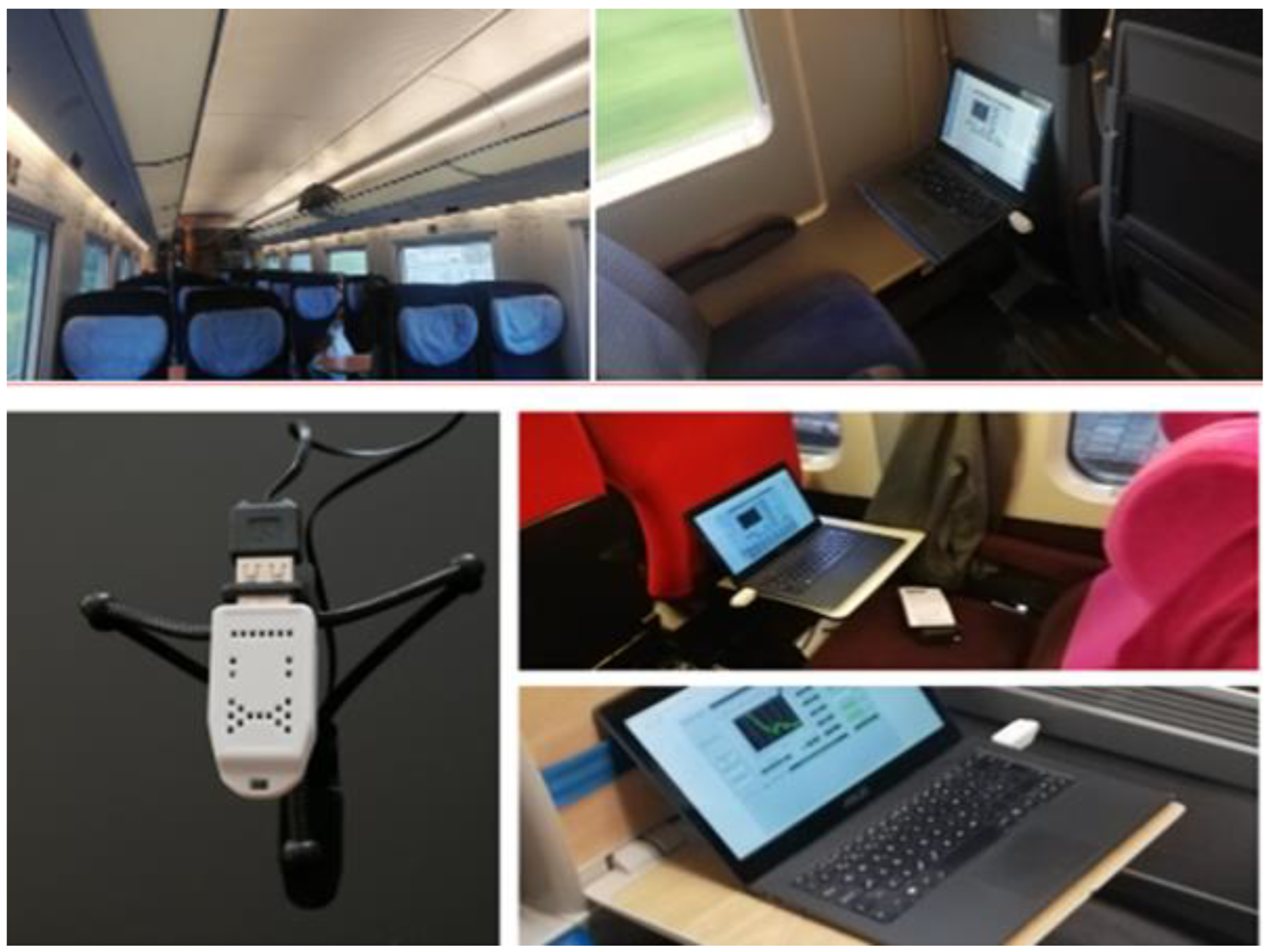
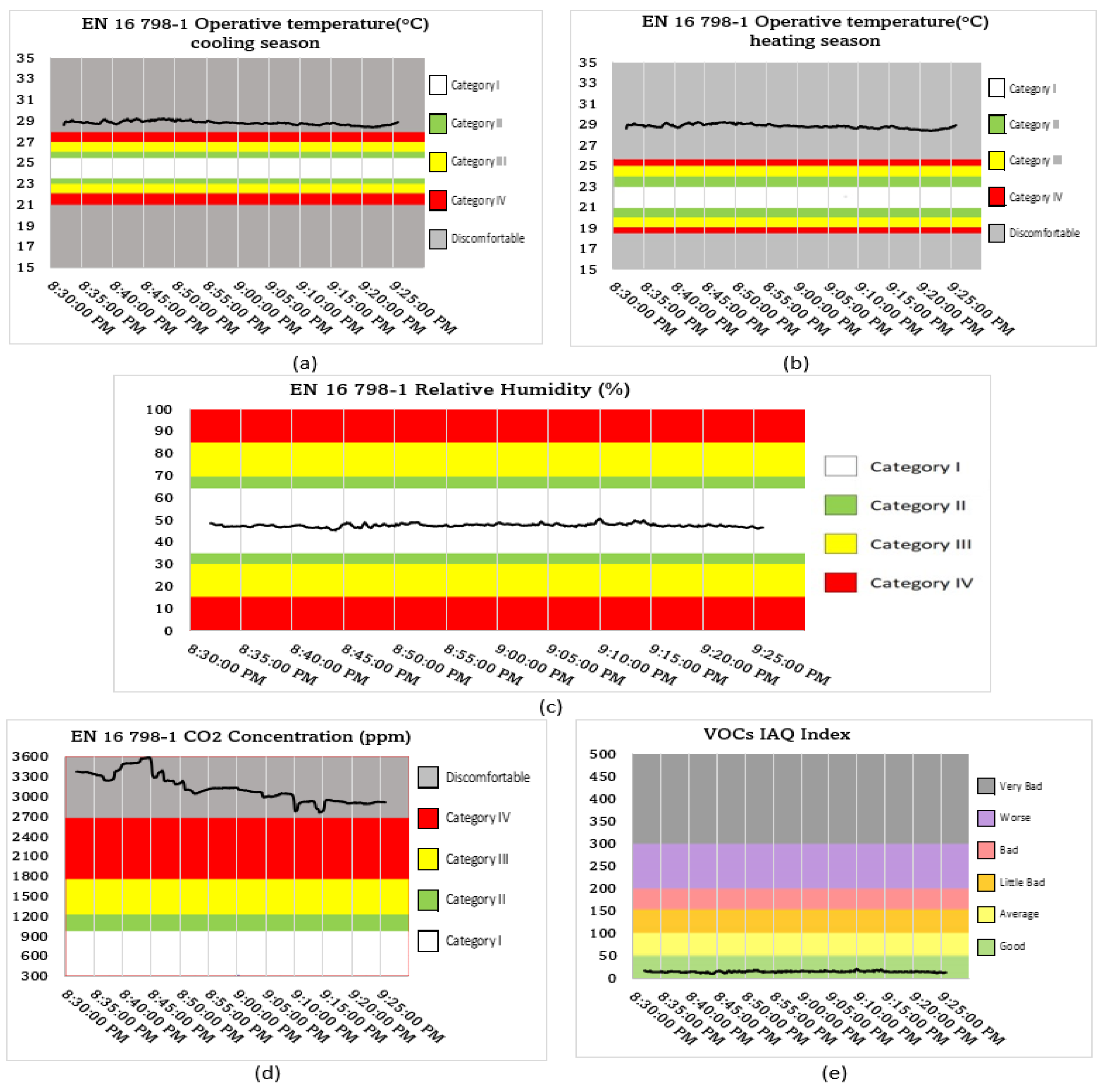
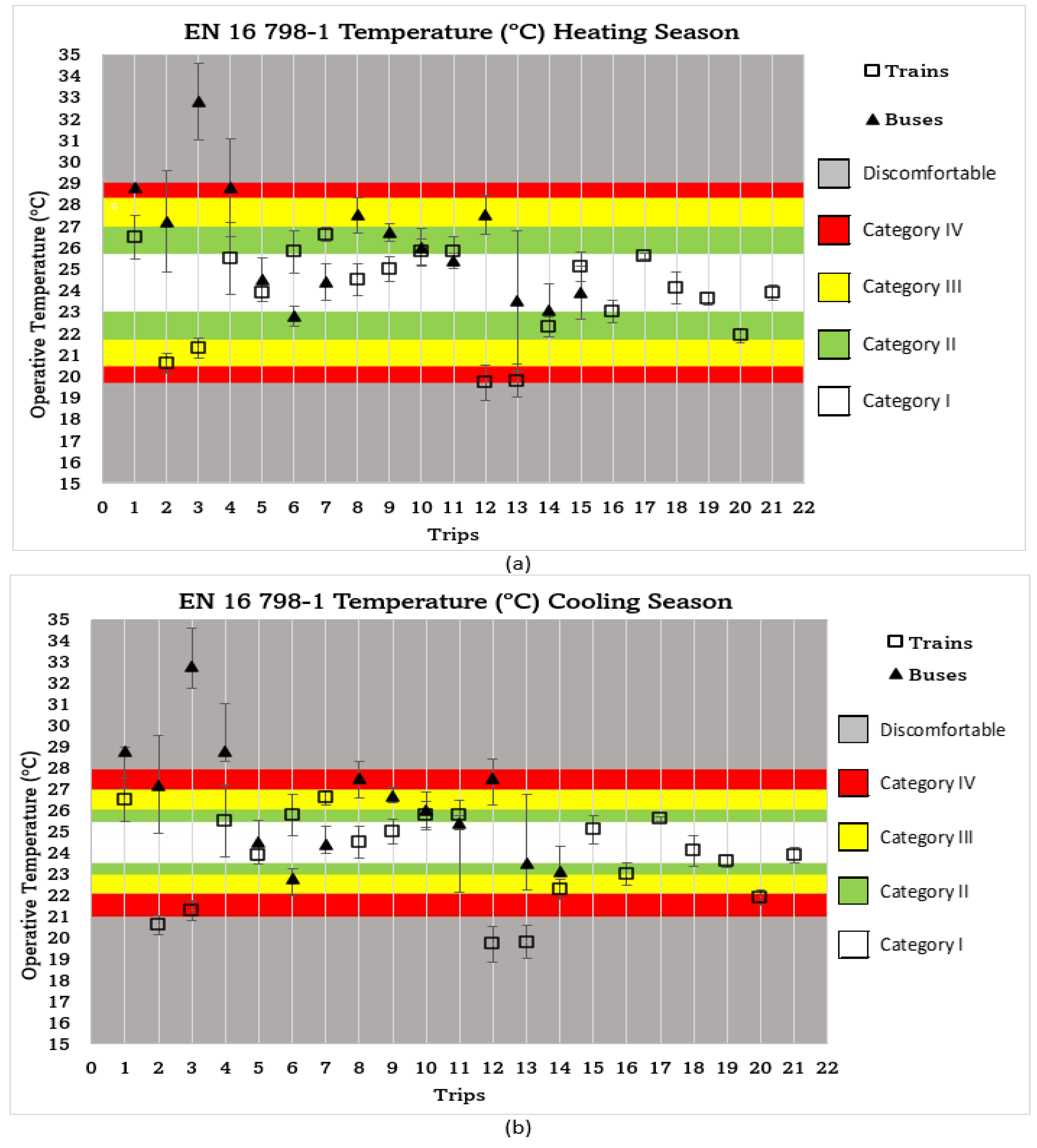

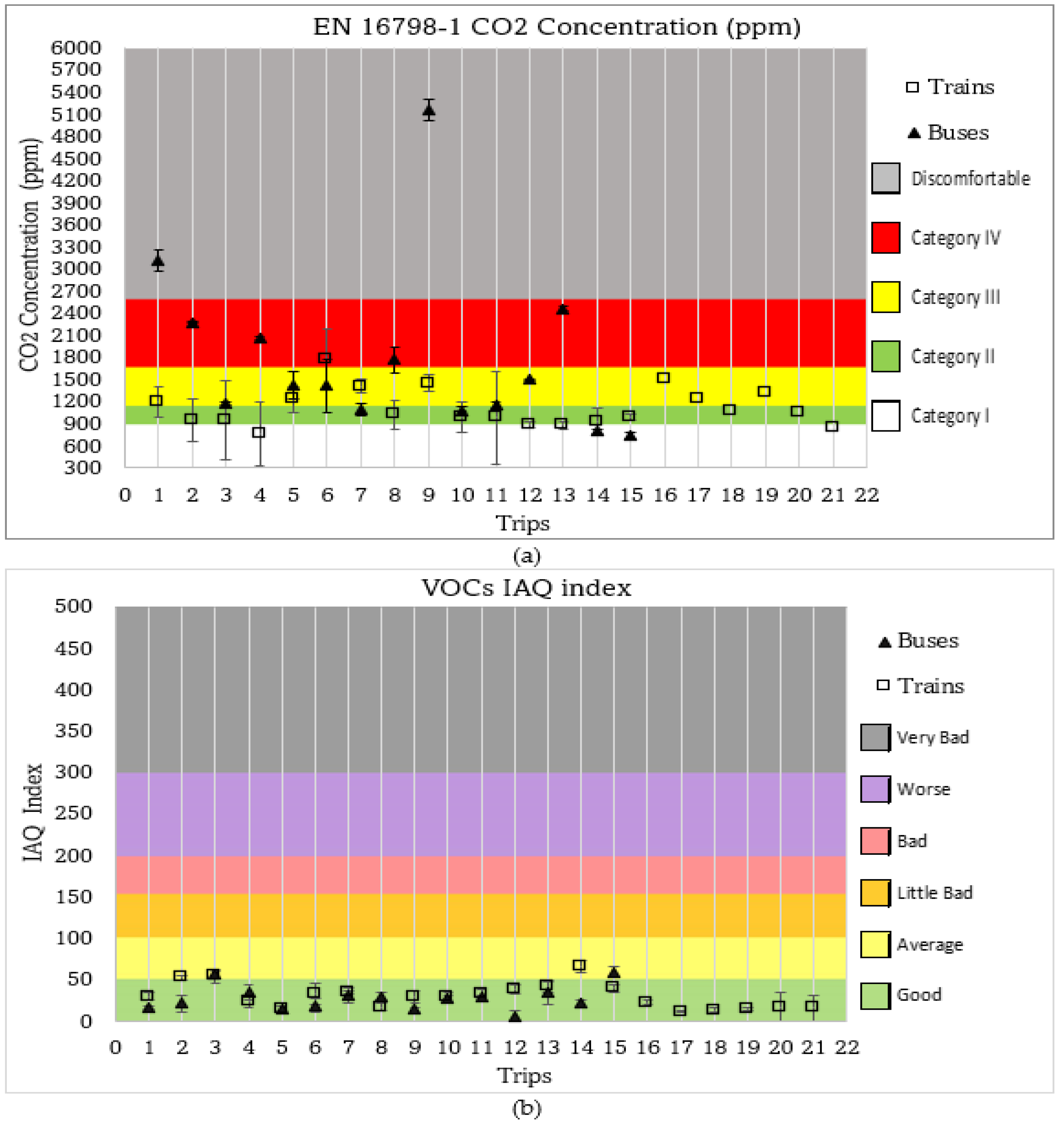
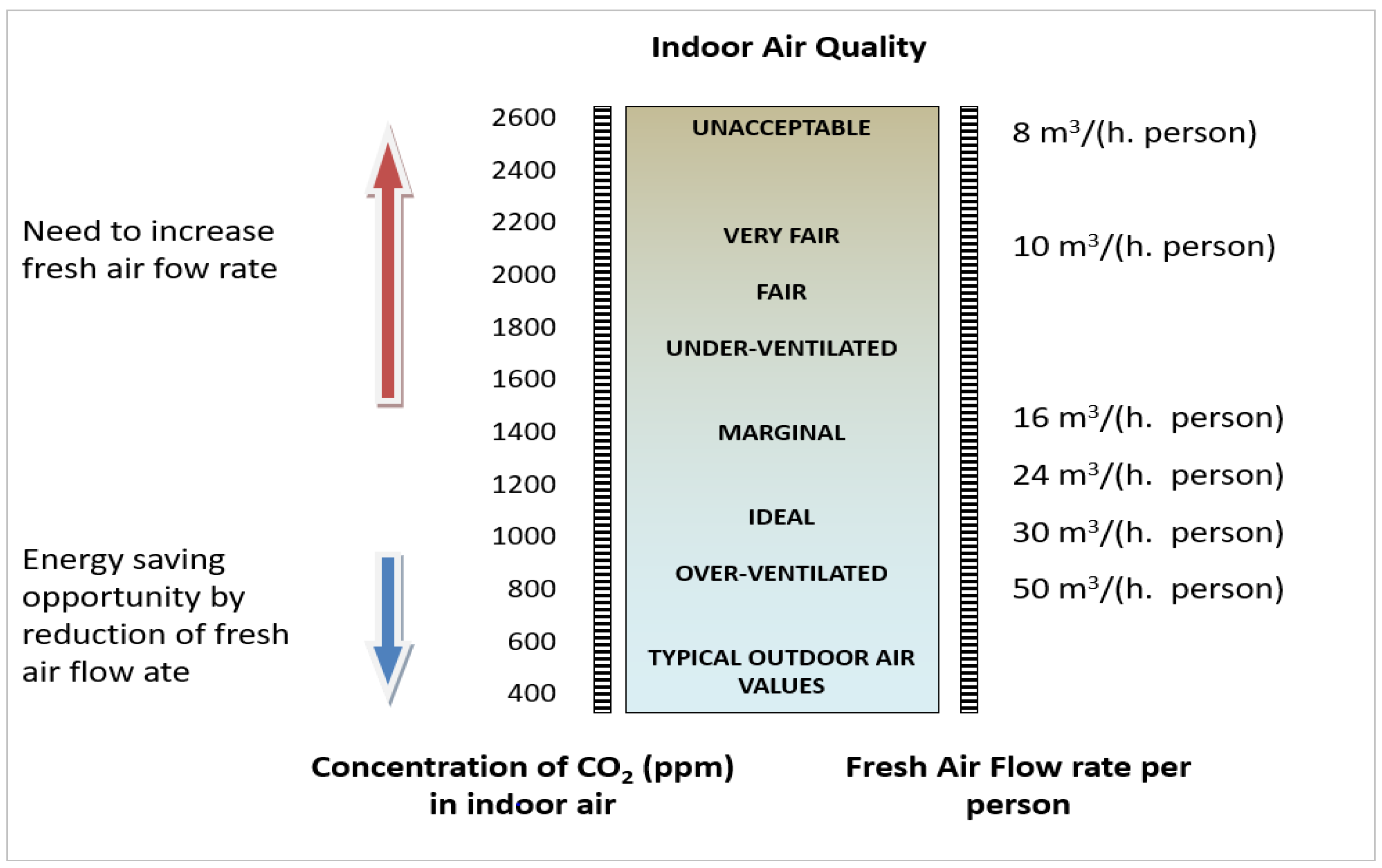
| Bus Trip | Route | Operator | Month | Seat | Season |
| 1 | Malpensa—Torino | Flibco | 7 | 11 | Cooling |
| 2 | Torino—Malpensa | Flibco | 7 | 7C | Cooling |
| 3 | Cartagena—Barranquilla | Flibco | 7 | 7 | Cooling |
| 4 | Barranquilla—Cartagena | Marsol | 8 | 7 | Cooling |
| 5 | Charleroi—Brussels | Marsol | 9 | 2A | Cooling |
| 6 | Coimbra—Madrid | Flix bus | 7 | 26 | Cooling |
| 7 | Lisbon—Coimbra | Royal express | 7 | - | Cooling |
| 8 | Madrid—Coimbra | Flix bus | 7 | 17V | Cooling |
| 9 | Coimbra—Lisbon | Coimbra shuttle | 9 | - | Cooling |
| 10 | Lisbon—Coimbra | Coimbra shuttle | 5 | 1C | Cooling |
| 11 | Coimbra—Coimbra | Flibco | 11 | - | Heating |
| 12 | Coimbra—Lisbon | Coimbra shuttle | 2 | 29 | Heating |
| 13 | Coimbra—Lisbon | Coimbra shuttle | 1 | - | Heating |
| 14 | Lisbon—Coimbra | Coimbra shuttle | 1 | - | Heating |
| 15 | Coimbra—Lisbon | Coimbra shuttle | 11 | - | Heating |
| b. Routes and train models. | |||||
| Train Trip | Route | Operator/typology | Month | Seat | Season |
| 1 | Coimbra—Lisbon | Cp Intercidades/URS | 6 | 11 | Cooling |
| 2 | Coimbra—Lisbon | Alfa Pendular/HST | 8 | 22 | Cooling |
| 3 | Coimbra—Lisbon | Alfa Pendular/HST | 8 | 22 | Cooling |
| 4 | Coimbra—Lisbon | Cp Intercidades/URS | 9 | 40 | Cooling |
| 5 | Poitiers—Paris | TGV/HST | 5 | 34 | Cooling |
| 6 | Erfurt—Jena | Regional-Train/URS | 5 | - | Cooling |
| 7 | Jena—Berlin | ICE/URS | 5 | - | Cooling |
| 8 | Frankfurt—Erfurt | ICE/URS | 5 | 42 | Cooling |
| 9 | Massy—Poitiers | TGV/HST | 3 | 76 | Heating |
| 10 | Lisbon—Coimbra | Cp Intercidades/URS | 10 | 24 | Heating |
| 11 | Lisbon—Coimbra | Cp Intercidades/URS | 10 | 24 | Heating |
| 12 | Lisbon—Coimbra | Alfa Pendular/HST | 10 | 36 | Heating |
| 13 | Lisbon—Coimbra | Alfa Pendular/HST | 10 | 36 | Heating |
| 14 | Lisbon—Coimbra | Alfa Pendular/HST | 10 | 36 | Heating |
| 15 | Coimbra—Lisbon | Cp Intercidades/URS | 11 | 23 | Heating |
| 16 | Brussels—Paris | TGV/HST | 11 | 85 | Heating |
| 17 | Paris—Poitiers | TGV/HST | 11 | 68 | Heating |
| 18 | Paris—Poitiers | TGV/HST | 11 | 68 | Heating |
| 19 | Paris—Poitiers | TGV/HST | 11 | 49 | Heating |
| 20 | Lisbon—Coimbra | Alfa Pendular/HST | 11 | 32 | Heating |
| 21 | Coimbra—Lisbon | Cp Intercidades | 11 | 46 | Heating |
| Equipment | Calibration | Resolution and Settings | Device Range |
| IEQ multiprobe device | Coverage factor (2), Probability (95%), TO (±0.2 °C), CO2 (±35 ppm), RH (±1%) | Omni directional probe, Sampling interval (5 s), Data logging via USB connection to a computer | CO2 (ppm), Operative temperature (°C)—TO, Relative humidity (%)—RH, Atmospheric pressure (Pa), VOCs, Illuminance (lux) |
| Operative Temperature (°C) | CO2 Concentration | VOC | ||||||
| Sedentary activity Air velocity < 0.1 m/s | Category | TO (°C) range for heating (Winter) ~1 clo/RH 40% | TO range for cooling (Summer) ~0.5 clo/RH 60% | Category | Corresponding CO2 concentration above outdoors for non-adapted individuals (ppm) | Category | IAQ Index | Air Quality |
| Offices and spaces with similar activity (conference room, single office) ~1.2 met | I | 21–23 | 23.5–25.5 | I | 550 | 10 | 0–50 | Good |
| II | 20–24 | 23–26 | II | 800 | 7 | 51–100 | Average | |
| III | 19–25 | 22–27 | III | 1350 | 4 | 101–150 | Little bad | |
| IV | 17–25 | 21–28 | IV | 1350 | 7 | 151–200 | Bad | |
| 201–300 | Worse | |||||||
| 301–500 | Very bad | |||||||
| Trips | Temp (°C) | RH (%) | Illuminance (lux) | Atm. Pres. (Pa) | CO2 (ppm) | VOC Index | HVAC Use |
| 1 | 28.8 | 48 | 1 | 997 | 3122 | 16 | Cooling |
| 2 | 27.2 | 50 | 575 | 985 | 2280 | 21 | Cooling |
| 3 | 32.8 | 67 | 686 | 1006 | 1181 | 56 | Cooling |
| 4 | 28.8 | 57 | 374 | 1003 | 2058 | 35 | Cooling |
| 5 | 24.5 | 47 | 4 | 1020 | 1424 | 15 | Cooling |
| 6 | 22.8 | 49 | 0 | 1017 | 1415 | 19 | Cooling |
| 7 | 24.4 | 55 | 14 | 1009 | 1094 | 31 | Cooling |
| 8 | 27.5 | 54 | 1 | 934 | 1771 | 30 | Cooling |
| 9 | 26.7 | 47 | 1 | 1002 | 5154 | 14 | Cooling |
| 10 | 26 | 47 | 0 | 1003 | 1073 | 28 | Cooling |
| 11 | 25.4 | 54 | 24 | 1011 | 1154 | 29 | Heating |
| 12 | 27.5 | 43 | 0 | 939 | 1502 | 6 | Heating |
| 13 | 23.5 | 57 | 122 | 1014 | 2462 | 35 | Heating |
| 14 | 23.1 | 50 | 0 | 1019 | 798 | 21 | Heating |
| 15 | 23.9 | 69 | 90 | 992 | 739 | 59 | Heating |
| Trips | Temp (°C) | RH (%) | Illuminance (lux) | Atm. Pres. (Pa) | CO2 (ppm) | VOC Index | HVAC Use |
| 1 | 26.5 | 54 | 84 | 1302 | 1205 | 30 | Cooling |
| 2 | 20.6 | 65 | 764 | 1016 | 952 | 53 | Cooling |
| 3 | 21.3 | 66 | 390 | 1010 | 947 | 55 | Cooling |
| 4 | 25.5 | 51 | 251 | 1016 | 770 | 24 | Cooling |
| 5 | 23.9 | 41 | 38 | 1007 | 1233 | 15 | Cooling |
| 6 | 25.8 | 48 | 1272 | 998 | 1777 | 33 | Cooling |
| 7 | 26.6 | 50 | 149 | 979 | 1407 | 35 | Cooling |
| 8 | 24.5 | 42 | 470 | 1014 | 1021 | 17 | Cooling |
| 9 | 25 | 47 | 79 | 991 | 1453 | 29 | Heating |
| 10 | 25.8 | 54 | 84 | 1012 | 987 | 29 | Heating |
| 11 | 25.8 | 56 | 129 | 1017 | 981 | 34 | Heating |
| 12 | 19.7 | 59 | 333 | 1019 | 895 | 39 | Heating |
| 13 | 19.8 | 60 | 358 | 1012 | 878 | 41 | Heating |
| 14 | 22.3 | 72 | 1390 | 1014 | 928 | 66 | Heating |
| 15 | 25.1 | 59 | 50 | 1010 | 986 | 40 | Heating |
| 16 | 23 | 51 | 45 | 992 | 1509 | 23 | Heating |
| 17 | 25.6 | 46 | 73 | 985 | 1233 | 12 | Heating |
| 18 | 24.1 | 46 | 116 | 988 | 1065 | 14 | Heating |
| 19 | 23.6 | 47 | 112 | 988 | 1316 | 15 | Heating |
| 20 | 21.9 | 48 | 774 | 1013 | 1046 | 17 | Heating |
| 21 | 23.9 | 47 | 27 | 1013 | 847 | 16 | Heating |
| Trips | PMV1 | PPD1 | PMV2 | PPD2 | PMV3 | PPD3 | PMV4 | PPD4 |
| 1 | 0.9 | 23 | −0.4 | 9 | 1.6 | 56 | 0.2 | 6 |
| 2 | −1.0 | 26 | −2.1 | 81 | 1.1 | 30 | −0.3 | 7 |
| 3 | −0.8 | 18 | −1.1 | 73 | 2.9 | 99 | 1.3 | 40 |
| 4 | −0.6 | 11 | −0.8 | 17 | 1.6 | 57 | 0.2 | 6 |
| 5 | 0.0 | 5 | −1.2 | 35 | 0.2 | 6 | −1.0 | 27 |
| 6 | 0.6 | 14 | −0.7 | 15 | −0.3 | 7 | −1.5 | 51 |
| 7 | 0.9 | 22 | −0.5 | 9 | −0.2 | 6 | −1.1 | 29 |
| 8 | 0.2 | 6 | −1.0 | 27 | 1.2 | 34 | −0.2 | 6 |
| 9 | 0.4 | 8 | −0.9 | 22 | 0.9 | 23 | −0.4 | 9 |
| 10 | 0.5 | 11 | −0.9 | 21 | 0.7 | 15 | −0.6 | 13 |
| 11 | 0.5 | 11 | −0.9 | 20 | 0.5 | 10 | −0.8 | 19 |
| 12 | −0.4 | 9 | −0.2 | 6 | 0.8 | 18 | −1.1 | 29 |
| 13 | −0.4 | 8 | −0.2 | 6 | 0.2 | 6 | −0.6 | 12 |
| 14 | 0.0 | 5 | −0.5 | 9 | 0.1 | 5 | −0.6 | 11 |
| 15 | 0.4 | 9 | −0.8 | 18 | −0.2 | 6 | −0.6 | 14 |
| 16 | 0.1 | 5 | −0.5 | 11 | ||||
| 17 | 0.5 | 10 | −0.8 | 20 | ||||
| 18 | 0.2 | 7 | −0.7 | 14 | ||||
| 19 | 0.2 | 6 | −0.6 | 13 | ||||
| 20 | 0.1 | 5 | −0.4 | 9 | ||||
| 21 | 0.2 | 6 | −0.6 | 14 |
Disclaimer/Publisher’s Note: The statements, opinions and data contained in all publications are solely those of the individual author(s) and contributor(s) and not of MDPI and/or the editor(s). MDPI and/or the editor(s) disclaim responsibility for any injury to people or property resulting from any ideas, methods, instructions or products referred to in the content. |
© 2024 by the authors. Licensee MDPI, Basel, Switzerland. This article is an open access article distributed under the terms and conditions of the Creative Commons Attribution (CC BY) license (https://creativecommons.org/licenses/by/4.0/).
Share and Cite
Ogundiran, J.O.; Nyembwe, J.-P.K.B.; Ribeiro, A.S.N.; da Silva, M.G. A Field Survey on Indoor Climate in Land Transport Cabins of Buses and Trains. Atmosphere 2024, 15, 589. https://doi.org/10.3390/atmos15050589
Ogundiran JO, Nyembwe J-PKB, Ribeiro ASN, da Silva MG. A Field Survey on Indoor Climate in Land Transport Cabins of Buses and Trains. Atmosphere. 2024; 15(5):589. https://doi.org/10.3390/atmos15050589
Chicago/Turabian StyleOgundiran, John Omomoluwa, Jean-Paul Kapuya Bulaba Nyembwe, Anabela Salgueiro Narciso Ribeiro, and Manuel Gameiro da Silva. 2024. "A Field Survey on Indoor Climate in Land Transport Cabins of Buses and Trains" Atmosphere 15, no. 5: 589. https://doi.org/10.3390/atmos15050589
APA StyleOgundiran, J. O., Nyembwe, J.-P. K. B., Ribeiro, A. S. N., & da Silva, M. G. (2024). A Field Survey on Indoor Climate in Land Transport Cabins of Buses and Trains. Atmosphere, 15(5), 589. https://doi.org/10.3390/atmos15050589









